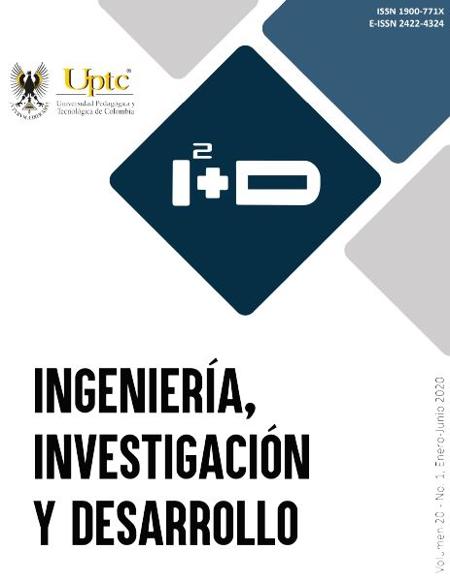Behavior of the inorganic chemistry of bituminous coals in the Checua - Lenguazaque syncline

Abstract
X - Ray Fluorescence Spectrometry is a technique that allows to obtain the percentages of the inorganic chemistry present in the coals of the western flank of the Checua - Lenguazaque syncline. Based on the results obtained, it is possible to determine the behavior of the inorganic chemistry of these coals, both in depth and in their extension, allowing a better understanding of the chemical variations and jointly determine the coals with better coking characteristics based on Fouling and Slagging factors.
Keywords
espectrometría de fluorescencia de rayos X, formación uaduas, fouling y slagging, química inorgánica del carbón, sinclinal Checua – Lenguazaque, Guaduas formation, fouling and slagging, coal inorganic chemistry, Checua – Lenguazaque syncline
References
- J. E. Mariño Martínez and E. Amaya, “Lithofacies cyclicity determination in the guaduas formation (Colombia) using Markov chains”, Earth sci. res. j., vol. 20, no. 3, pp. B1-B9, Julio. 2016. https://doi.org/10.15446/esrj.v20n3.44429 DOI: https://doi.org/10.15446/esrj.v20n3.44429
- J. A. Barrera Pongutá, “Determinación de la madurez térmica de los carbones de la formación guaduas en el Sinclinal Checua - Lenguazaque”. (Trabajo de pregrado). Universidad Pedagógica y Tecnológica de Colombia, Sogamoso. (2016). Disponible en: http://repositorio.uptc.edu.co/handle/001/1691
- G. A. Sarmiento Pérez y C. L. Guatame, “Interpretación del Ambiente Sedimentario de los Carbones de la Formación Guaduas en el
- Sinclinal Checua-Lenguazaque a partir del análisis petrográfico”, Geología Colombiana, pp. 41-58, enero. 2004.
- J. S. Gómez Neita, M. D. López Carrasquilla, “Paleoenvironments of coals using organic petrography and their relationship with physicochemical properties, Guaduas formation, Checua-Lenguazaque syncline”. (Trabajo de grado). Universidad Pedagógica y Tecnológica de Colombia, Sogamoso. (2017). Disponible en: http://repositorio.uptc.edu.co/handle/001/1875
- C. R. Ward, “Analysis, origin and significance of mineral matter in coal: An updated review”. International Journal of Coal Geology, no. 165, DOI: https://doi.org/10.1016/j.coal.2016.07.014
- p.p. 1–27. 2016. https://doi.org/10.1016/j.coal.2016.07.014 DOI: https://doi.org/10.14220/lhom.2016.27.2.1
- L. Thomas, “Coal Sampling and Analysis”. Coal Geology, L. Thomas, Ed. Reino Unido: John Wiley & Sons, Ltd, 2012. pp. 137–149. DOI:10.1002/9781118385685 DOI: https://doi.org/10.1002/9781118385685.ch5
- M. C. Valentinuzzi, “Análisis por Fluorescencia de Rayos X: Implementación de Guías de Haces en Reflexión Total”. Trabajo de Grado de Doctorado. Facultad de Matemática, Astronomía y Física. Universidad Nacional de Córdoba. Argentina. 2008.
- F. Frandsen, “Empirical Prediction of Ash Deposition Propensities in Coal-Fired Utilities”. Department of Chemical Engineering Technical University of Denmark. Dinamarca, ene, 1997, pp. 3 – 6. Disponible en: https://www.osti.gov/etdeweb/servlets/purl/594959
- Mohammad Zahari Sukimi Mat Zaid, Mazlan Abdul Wahid, Musa Mailah, Mohammad Amri Mazlan, and Aminuddin Saat, “Coal combustion analysis tool in coal fired power plant for slagging and fouling guidelines”, AIP Conference Proceedings 2062, pp. 1 – 7. enero, 2019. https://doi.org/10.1063/1.5086575 DOI: https://doi.org/10.1063/1.5086575
- A. Badii, O. P. Guillen, S. Lugo, & J. J. Aguilar Garnica, “Correlación No-Paramétrica y su Aplicación en la Investigaciones Científicas. Non-Parametric Correlation and Its Application in Scientific Research”. International Journal of Good Conscience, vol. 9, no. 2, pp. 31–40, Agosto, 2014.
- M. G. Kendall, B. B. Simith, “Randomness and Random sampling numbers”, pp. 103, 147-166, 1938. https://doi.org/10.2307/2980655 DOI: https://doi.org/10.2307/2980655
